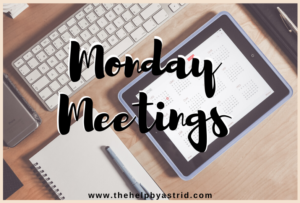
How many times have you said after attending a long drawn out, very boring meeting, “well, that could’ve just been an email!” Many people check out of meetings and start scrolling through their social media feed after while. It could be for a host of reasons: they shouldn’t have been included in the attendee’s list, the presider was ill-prepared, the meeting is too long, too boring, or not relevant to the attendee, etc.
But have you stopped to wonder if maybe you set the meeting during the wrong time of the week? You may be asking, “Is that even a thing?” Apparently, yes! Researchers[1] suggest that the worst time to schedule a meeting is during Monday mornings.
Right now, I can imagine that most of you are going…nooooo! Many businesses, especially those that involve teams, start the week with a Monday morning meeting. And with good intentions, since most of these meetings act as a sort of a huddle – a way to make sure that everyone is on the same page and to make sure jobs are assigned and projects are evaluated for progress.
Why not Mondays?
Mondays are statistically believed to be the most productive day of the week for employees. Many employees hunker down and get to work right away, so it is imperative that their concentration is not disrupted by having to attend meetings. Also, statistically, most employees choose Mondays or Fridays to call in sick or even file for leave to get a long weekend. So Monday morning meetings are probably prone to a lot of no-shows.
If not Mondays, when?
Science shows that the best day to hold meetings is Tuesday at 2:30pm. This data was derived from more than 2 million responses to 530,000 meeting invitations. The reason: it’s not too early in the morning and also not too late in the week. You can still steer the direction of projects and get updates early enough in the workweek and it’s not too early in the day to cut through the productive hours of employees.
Optimal meetings
No matter how well you schedule your meetings, if it’s boring or not very well prepared, people are going to zonk out. Here re a few tips to keep it engaging:
- Keep it short – keep it within 45 mins, that’s the sweet spot. Half an hour is too short and should just be an email. An hour or more is just too long and will likely feel like a drag to attendees.
- Distribute materials in advance – if you have materials for review or comments, please send them out in advance. Don’t assume that people will be able to give relevant input while you go through your presentation slides that they’re seeing for the first time.
- Open with a purpose, close with action – set expectations at the beginning. What do you need to address? What needs to be accomplished? Answer that throughout the meeting and then close with a plan of action.
Do you like attending meetings? What are your meeting survival tips? Share your tips with us in the comments. Remember to work smart and be a blessing to someone today.
Written by Jaie O. TheHelp
[1] https://www.payscale.com/career-news/2016/07/science-says-best-day-time-meeting

 Do you know what the biggest time waster at work is? No, it’s not checking your social media updates. Take another guess.
Do you know what the biggest time waster at work is? No, it’s not checking your social media updates. Take another guess.